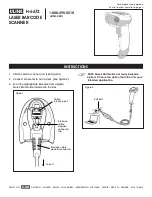
Copyright © Access-IS 2015
Page
2
of
39
Document History
Issue
Date
Revised By
Description
1.0
05/03/2015
Andrew Covey
Initial Distribution
1.1
05/06/2015
Andrew Covey
First Full Release
1.2
21/08/2015
Andrew Covey
Typographical Update
Warnings
This manual contains important information regarding the installation and operation of the ATR110 2D
Barcode Imager. For safe and reliable operation of the imager, installers must ensure that they are familiar
with and fully understand all instructions contained herein.
Warranty
Access Ltd warrants that this product shall be free from defects in workmanship and materials for a period of
one year from the date of original purchase. If the product should fail to operate correctly in normal use during
the warranty period, Access will replace or repair it free of charge. No liability can be accepted for damage
due to misuse or circumstances outside Access’ control. Also Access will not be responsible for any loss,
damage or injury arising directly or indirectly from the use of this product. Access total liability under the terms
of this warranty shall in all circumstances be limited to the replacement value of this product.
Radio Frequency Energy
European EMC directive 89/336/EEC
This equipment has been tested and found to comply with the limits for a class A
computing device in accordance with the specifications in the European standard
EN55022. These limits are designed to provide reasonable protection against harmful
interference. This equipment generates, uses and can radiate radio frequency energy and
if not installed and used in accordance with the instructions may cause harmful
interference to radio or television reception. However, there is no guarantee that harmful
interference will not occur in a particular installation. If this equipment does cause interference to radio or
television reception, which can be determined by turning the equipment on and off, the user is encouraged to
correct the interference with one or more of the following measures: (a) Reorient or relocate the receiving
antenna. (b) Increase the separation between the equipment and the receiver. (c) Connect the equipment to
an outlet on a circuit different from that to which the receiver is connected. (d) Consult the supplier or an
experienced radio / TV technician for help.
FCC Compliance Statement (United States)
This equipment generates, uses and can radiate radio frequency energy and if not installed and used
properly, that is, in strict accordance with the manufacturer’s instructions, may cause interference to radio
communication. It has been tested and found to comply with the limits for a class A computing device in
accordance with the specifications in Subpart J of part 15 of FCC rules, which are designed to provide
reasonable protection against such interference when the equipment is operated in a commercial
environment. Operation of this equipment in a residential area may cause interference, in which case the user
at his own expense will be required to take whatever measures may be necessary to correct the interference.
Changes or modifications not expressly approved by the manufacturer could void the user’s authority to
operate the equipment.
Canadian Department of Communications RFI statement
This equipment does not exceed the class A limits for radio noise emissions from digital apparatus set out in
the radio interference regulations of the Canadian Department of Communications.
Le présent appareil numérique n’émet pas de bruits radioélectriques dépassant les limites applicables aux
appareils numériques de la classe A prescrites dans le règlement sur le brouillage radioélectriques publié par
le ministère des Communications du Canada.



































